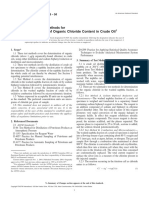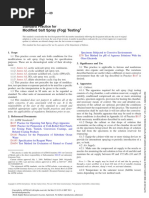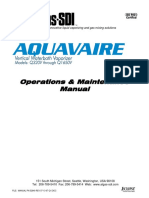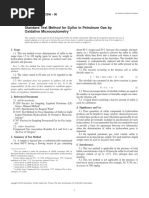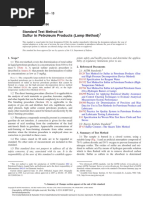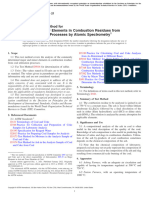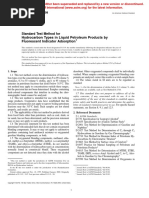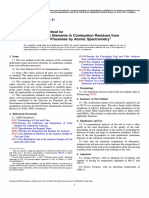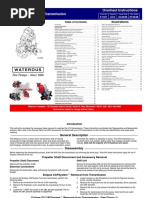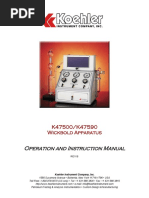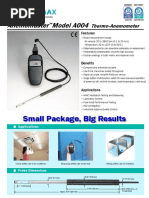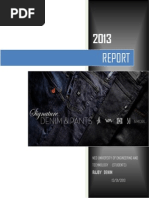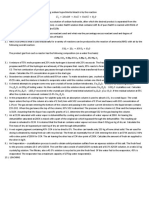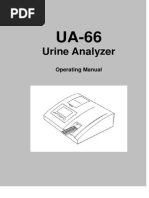D2784-11 Azufre Oxy Hidrógeno
D2784-11 Azufre Oxy Hidrógeno
Uploaded by
KALATUSCopyright:
Available Formats
D2784-11 Azufre Oxy Hidrógeno
D2784-11 Azufre Oxy Hidrógeno
Uploaded by
KALATUSCopyright
Available Formats
Share this document
Did you find this document useful?
Is this content inappropriate?
Copyright:
Available Formats
D2784-11 Azufre Oxy Hidrógeno
D2784-11 Azufre Oxy Hidrógeno
Uploaded by
KALATUSCopyright:
Available Formats
Designation: D2784 – 11
Standard Test Method for
Sulfur in Liquefied Petroleum Gases (Oxy-Hydrogen Burner
or Lamp)1
This standard is issued under the fixed designation D2784; the number immediately following the designation indicates the year of
original adoption or, in the case of revision, the year of last revision. A number in parentheses indicates the year of last reapproval. A
superscript epsilon (´) indicates an editorial change since the last revision or reapproval.
1. Scope* 2.2 Energy Institute Standard:3
1.1 This test method covers the determination of total sulfur IP 181 Sampling Petroleum Gases, Including Liquefied
in liquefied petroleum gases containing more than 1 µg/g. Petroleum Gases
Specimens should not contain more than 100 µg/g of halogens. 3. Summary of Test Method
1.2 To attain the quantitative detectability that the test
method is capable of, stringent techniques must be employed 3.1 The sample is burned in an oxy-hydrogen burner, or in
and all possible sources of sulfur contamination must be a lamp in a closed system in a carbon dioxide-oxygen
eliminated. In particular, cleaning agents, such as common atmosphere. The latter is not recommended for trace quantities
household detergents which contain sulfates, should be of sulfur due to the inordinately long combustion times needed.
avoided. The oxides of sulfur are absorbed and oxidized to sulfuric acid
1.3 The values stated in SI units are to be regarded as in a hydrogen peroxide solution. The sulfate ions are then
standard. The values given in parentheses are for information determined by either of the following finishes:
only. 3.1.1 Barium Perchlorate Titration—The sulfate is titrated
1.4 This standard does not purport to address all of the with barium perchlorate using a thorin-methylene blue mixed
safety concerns, if any, associated with its use. It is the indicator.
responsibility of the user of this standard to establish appro- 3.1.2 Turbidimetric—The sulfate is precipitated as barium
priate safety and health practices and determine the applica- sulfate and the turbidity of a suspension of the precipitate is
bility of regulatory limitations prior to use. measured with a photometer.
2. Referenced Documents 4. Significance and Use
2.1 ASTM Standards:2 4.1 It is important to have the sulfur content of liquefied
D156 Test Method for Saybolt Color of Petroleum Products petroleum gases at low enough concentration to meet govern-
(Saybolt Chromometer Method) ment regulations. The presence of sulfur can result in corrosion
D1193 Specification for Reagent Water of metal surfaces. Sulfur can be poisonous to catalysts in
D1265 Practice for Sampling Liquefied Petroleum (LP) subsequent processing.
Gases, Manual Method 5. Apparatus
D1266 Test Method for Sulfur in Petroleum Products
(Lamp Method) 5.1 Oxy-Hydrogen Combustion Assembly—The two types
D1657 Test Method for Density or Relative Density of listed below are recommended. Any combustion apparatus
Light Hydrocarbons by Pressure Hydrometer giving equivalent results, however, is satisfactory.
E11 Specification for Woven Wire Test Sieve Cloth and Test 5.1.1 Wickbold-Type Combustion Apparatus, as shown in
Sieves Fig. 1.
5.1.2 Modified Beckman Burner-Type Apparatus,4,5 as
shown in Fig. 2. Each of the above types of apparatus shall
1
consist of three parts: atomizer-burner, combustion chamber,
This test method is under the jurisdiction of ASTM Committee D02 on
Petroleum Products and Lubricants and is the direct responsibility of Subcommittee
D02.03 on Elemental Analysis.
3
Current edition approved Jan. 1, 2011. Published February 2011. Originally Available from Energy Institute, 61 New Cavendish St., London, WIG 7AR,
approved in 1969. Last previous edition approved in 2006 as D2784–06. DOI: U.K., http://www.energyinst.org.uk.
4
10.1520/D2784-11. The sole source of supply of the apparatus known to the committee at this time
2
For referenced ASTM standards, visit the ASTM website, www.astm.org, or is Scientific Glassblowing Co., P.O. Box 18353, Houston, TX 77023.
5
contact ASTM Customer Service at service@astm.org. For Annual Book of ASTM If you are aware of alternative suppliers, please provide this information to
Standards volume information, refer to the standard’s Document Summary page on ASTM International Headquarters. Your comments will receive careful consider-
the ASTM website. ation at a meeting of the responsible technical committee,1 which you may attend.
*A Summary of Changes section appears at the end of this standard.
Copyright (c) ASTM International. 100 Barr Harbor Drive PO box C-700, West Conshohocken, PA. United States
Copyright by ASTM Int'l (all rights reserved); 1
D2784 – 11
5.4 Corrosion-Resistant Metal Cylinder, 75-mL—It shall be
tested at a pressure of 600 psig (4.14 MPa gage) and shall show
no leaks when filled with air or nitrogen to this pressure and
submerged in water. It shall be fitted with a needle valve for
connection to the burner assembly.
5.5 Variable Transformer, 0–120 V, 750-W.
5.6 Carbon Dioxide Pressure Regulator—This regulator
should be of a type that eliminates the refrigeration difficulties
occurring with the pressure reduction of carbon dioxide.5,6
6. Reagents and Materials
6.1 Purity of Reagents—Reagent grade chemicals shall be
used in all tests. Unless otherwise indicated, it is intended that
all reagents shall conform to the specifications of the Commit-
tee on Analytical Reagents of the American Chemical Society,
where such specifications are available.7 Other grades may be
used, provided it is first ascertained that the reagent is of
sufficiently high purity to permit its use without lessening the
accuracy of the determination.
6.2 Purity of Water—Unless otherwise indicated, references
to water shall be understood to mean reagent water as defined
by Types II or III of Specification D1193. Water conforming to
the following specification is required. Sulfate-free deionized
1—Atomizer-burner
2—Sample tube water prepared by percolation of water through a column of
3—Combustion chamber mixed anion and cation exchange resins.
4—Three-way stopcock
5—Receiver NOTE 1—A means for determining when to replace the exchange resins
6—Spray trap should be provided. Use of a simple electrical conductivity meter has been
FIG. 1 Flow Diagram of a Typical Oxy-Hydrogen Combustion found satisfactory for this purpose.
Apparatus 6.3 Standard Sulfate Solution (1 mL = 100 µg S)—Dilute
6.24 6 0.01 mL of 1 N sulfuric acid (H2SO4) with water to
exactly 1 L. Check the dilution by titration against standard
and absorber with spray trap. A blowout safety port in the NaOH solution of about the same normality and adjust the
combustion chamber is desirable. The remainder of the appa- concentration, if necessary, so that each millilitre of this
ratus shall consist of a suitable support stand with the necessary solution is equivalent to 100 µg of sulfur.
needle valves and flow meters for precise control of oxygen, 6.4 Hydrogen (Warning—Extremely flammable), Carbon
hydrogen, and vacuum. Dioxide (Warning—Gas may reduce oxygen available for
5.1.3 Safety Shield—A transparent shield shall be used to breathing), and Oxygen (Warning—Oxygen accelerates com-
protect the operator in the event an explosive mixture is formed bustion), meeting the requirement in Note 13.
in the combustion chamber. 6.5 Scavenger-Rinse—Mix equal volumes of low-sulfur
5.2 Apparatus for Lamp Combustion: acetone and isopropanol.
5.2.1 Absorbers, Chimneys, and Spray Traps, as required 6.6 Hydrogen Peroxide Solution (1.5 %) (1 + 19)—Mix 1
are described in detail in Annex A3 of Test Method D1266. volume of concentrated hydrogen peroxide (H2O2 = 30 %)
5.2.2 Manifold System, consisting of a vacuum manifold with 19 volumes of water. Store in a dark-colored, glass-
with regulating device, valves, etc. (Fig. 2 of Test Method stoppered bottle.
D1266) and a dual manifold (burner and chimney) supplying a 6.7 Quality Control (QC) Sample(s), preferably are portions
gas mixture of approximately 70 % carbon dioxide (CO2) and of one or more liquefied petroleum gas materials or product
30 % oxygen (O2) at regulated pressures. The gas mixture in standards of known sulfur content that were not used in the
the chimney manifold shall be maintained at a nearly constant generation of the instrument calibration curve. These (QC)
pressure of 1 to 2 cm of water and the burner manifold at samples are to be used to check the validity of the testing
approximately 20 cm of water. A suitable arrangement is
shown in Fig. 2 of Test Method D1266 and described in A3.6
6
of Annex A3 of Test Method D1266, but any other similar The sole source of supply of the Victor Type SR 300 regulator known to the
committee at this time is Victor Equipment Co., Controls Division, 2336 Auburn
system giving equivalent results can be used. Blvd., Sacramento, CA 95821.
5.2.3 Blast Type Gas Burner, having dimensions given in 7
Reagent Chemicals, American Chemical Society Specifications, American
Fig. 3. Chemical Society, Washington, DC. For Suggestions on the testing of reagents not
listed by the American Chemical Society, see Annual Standards for Laboratory
5.3 Vacuum Source, having a capacity of at least 1200 L/h. Chemicals, BDH Ltd., Poole, Dorset, U.K., and the United States Pharmacopeia
If a vacuum pump is used, it should be protected by a suitable and National Formulary, U.S. Pharmacopeial Convention, Inc. (USPC), Rockville,
trap. MD.
Copyright by ASTM Int'l (all rights reserved); 2
D2784 – 11
FIG. 2 Trace Sulfur Apparatus Flow Diagram
NOTE 3—The corresponding liquid petroleum gas sample density of the
material being analyzed by this test method for sulfur will ultimately
determine the maximum weight that can be introduced into the 75-mL
cylinder without becoming full of liquid. This maximum weight value
needs to be compared to the sample sizes in Table 1 needed for the
corresponding finishes and expected sulfur concentrations indicated for
determining the appropriate sample weight that needs to be introduced
into the cylinder in 7.2. As an example, if the sample density is 0.6 g/mL
at room temperature, and if the weight of the liquefied petroleum gas is
maintained below 45 g in a 75-mL container, the container cannot become
full of liquid at room temperature.
8. Procedure for Combustion of Sample
8.1 Connect the sample cylinder with stainless steel tubing
to the gas expansion valve. Attach to this another section of
stainless steel tubing which runs to the vicinity of the burner.
Make the final connection to the burner with sulfur-free rubber
All dimensions in millimetres tubing. Wrap the expansion valve with heating tape and
FIG. 3 Blast-Type Gas Burner connect this to a variable transformer. Insert a thermometer
between the heating tape and expansion valve so that the
thermometer bulb is in contact with the valve body. See Fig. 4.
process as described in Section 16. An ample supply of QC NOTE 4—Other temperature measuring devices such as thermocouples
sample material shall be available for the intended period of or resistance thermometers, may be used when the temperature readings
use, and must be homogeneous and stable under the anticipated obtained by these devices are determined to produce the same results that
storage conditions. are obtained when mercury-in-glass thermometers are used. The precision
and bias given in Section 18 may or may not apply in such cases since the
7. Sampling Test Specimens and Test Units published precision is based on an interlaboratory study where only
mercury-in-glass thermometers were used. No information on the effect
7.1 Obtain the test unit in a container by the method on precision when using alternative temperature measuring devices is
conforming to the recommendations in Practice D1265, or IP available.
Method 181.
8.2 Turn on the variable transformer and allow the expan-
7.2 Evacuate a clean, dry 75-mL cylinder and weigh to the
sion valve to reach 43°C (110°F). Alternatively the expansion
nearest 0.05 g. Connect the container to the inverted supply
valve may be placed in a suitable metal beaker and covered
cylinder and introduce 24 to 45 g of the liquefied gas, taking
with water maintained at 110°F.
care that the container does not become full of liquid. To
8.3 Oxy-Hydrogen Combustion—Assemble the apparatus
prevent this, bleed off a small amount of the liquid phase of the
according to the manufacturer’s directions (see also 14.1). Add
material after filling but before reweighing. Reweigh the
to the absorber 25 mL of the hydrogen peroxide solution.
cylinder to 0.05 g.
(Warning—Before attempting subsequent operations, the op-
NOTE 2—The 75-mL, corrosion-resistant metal vessel can be cleaned as erator should (1) be aware of the various hazards that can exist
follows: Remove the needle valve. Wash the interior of the vessel and through the improper use of hydrogen as a fuel, and (2) have
valve, first with a sulfur-free hydrocarbon, such as n-pentane, and then the safety shield in place.)
wash with acetone. Dry the interior of the vessel with clean compressed
air and rinse it with HCl (1 + 10). Rinse the interior with water until the
8.3.1 Light the burner and insert into the combustion
wash water is neutral to a pH test paper. Wash the vessel with acetone and chamber. If necessary, readjust gas flows. Open the bottom
allow to drain at least 10 min. Dry the vessel with a stream of clean, valve of the sample cylinder. Slowly open the expansion valve
compressed air and reassemble. until an optimum burning rate is achieved.
Copyright by ASTM Int'l (all rights reserved); 3
D2784 – 11
TABLE 1 Sample Sizes 8.11 Disconnect the spray trap from the vacuum line and
Sulfur Content, ppm
Sample Size, g thoroughly rinse the spray trap and chimney with about 35 mL
Turbidimetric Finish Barium Perchlorate Finish of distilled water, collecting the rinsings in the absorber. It is
A
1 to 5 45 30
5 to 10 20 10 important that any materials clinging to these parts be trans-
10 to 50 5 3 ferred to the absorber to avoid low values for sulfur content.
A
If 45 g is unable to be introduced into the 75-mL cylinder due to the
corresponding sample density (see Note 3), it is permissible to use a smaller BARIUM PERCHLORATE TITRATION FINISH
sample size that corresponds to a sample weight that is maximized in the cylinder
without becoming full of liquid. Users of this test method faced with this smaller 9. Reagents
sample size restriction are cautioned that results may be affected.
9.1 Ion-Free Water—Distill deionized water and store in
tightly capped, high-density polyethylene bottles.
8.4 Lamp Combustion—Add to the absorber 25 mL of 9.2 Hydrochloric Acid, Standard Alcoholic (0.1 M)—Dilute
hydrogen peroxide solution. Assemble the chimney, absorber, 20 mL of aqueous 0.5 M HCl with 80 mL of isopropanol.
and spray trap and connect to the CO2-O2 and vacuum 9.3 Inhibited Thorin-Methylene Blue Mixed Indicator
manifold. Make the necessary vacuum adjustments (see 5.1 of Solution—The indicator is made up as two solutions and these
Test Method D1266). Set up a control blank absorber as in 5.3 mixed together in equal volumes once per week as follows:
of Test Method D1266. Solution A:
8.4.1 Open the bottom valve of the sample cylinder. Slowly 0.8 g thorin,5,8 0.29 g potassium bromate, water to make 500 mL
crack the gas expansion valve. Light the burner with an alcohol Solution B:
lamp, and insert the burner into the combustion chamber 0.16 g methylene blue, 0.2 mL of 0.5 M HCl, water to make 500 mL
(chimney). 9.4 Fleisher’s Methyl Purple Indicator Solution.5,9
8.5 Burn a quantity of sample in accordance with Table 1. 9.5 Barium Perchlorate (0.005 M)—Dissolve 1.95 g of
NOTE 5—In burning materials with sulfur concentrations greater than barium perchlorate trihydrate5,9 in 200 mL of water and add
50 µg/g, restrict sample sizes to give quantities that will not contain more 800 mL of isopropanol. Adjust the apparent pH to about 3.5
than 250 µg of sulfur for the turbidimetric finish or more than 150 µg for with perchloric acid, using a pH meter.
the barium perchlorate finish. Alternatively, aliquots of the absorber 9.6 Perchloric Acid,5,10 70 %.
solutions which do not contain more than these maximums can be used.
9.7 Sodium Hydroxide, Standard Solutions (0.03 M)—
NOTE 6—Minor adjustment of the gas flow rates can be necessary to
maintain those recommended by the manufacturer. Prepare by mixing 7 parts of water with 3 parts of standard 0.1
M sodium hydroxide (NaOH) solution. Concentrate 400 mL of
8.6 After a sufficient quantity of sample has been burned, 0.03 N NaOH solution by evaporating to 30 mL, and determine
turn the bottom valve of the cylinder off. Allow the remaining any sulfate present in accordance with Appendix A1, Turbidi-
gas in the tubing and gas expansion valve to burn itself out. metric Procedure for Sulfate of Test Method D1266. If sulfate
Turn the heat off on the gas expansion valve. Disconnect the is found, corrections must be made for any sulfur introduced by
tubing from the sample cylinder and reweigh the sample the reagent in the alkali titration following combustion.
cylinder to the nearest 0.05 g. Leave the absorber solution in 9.8 Methylene Blue.
the assembled lamp unit. The same absorber solution will be
used for the scavenger-rinse burning. Allow the expansion 10. Preparation of Working Curve
valve to cool to ambient temperature. 10.1 Into separate 30-mL beakers pipet each of the aliquots
8.7 If the oxy-hydrogen burner permits, flush the tubing and of the standard sulfate solution given in Table 2. See 6.3. To
valve with 10 mL of scavenger-rinse and burn without discon- each aliquot add sufficient water to make 3.4 mL, 12 mL of
necting the tubing. Otherwise disconnect the tubing and burn in isopropanol (total volume 15.4 mL) and 3 drops of mixed
the normal liquid mode. For the lamp burning collect the thorin-methylene blue indicator solution. Titrate as indicated
rinsings in a standard lamp sulfur (see Test Method D1266) below. For each sulfur level given in Table 2, titrate three of the
flask. Insert a standard burner equipped with a wick into the corresponding aliquots. Plot the millilitres of titrant used
flask and carry out the combustion as described in Section 7 of versus micrograms of sulfur. Draw the best straight line
Test Method D1266. through points. Check at least two points on the curved at least
8.8 For the oxy-hydrogen burners, when all of the rinsings every 10 days.
are consumed, shut down the burner as recommended by the
manufacturer. 11. Procedure for Analysis of Solutions
8.9 After the rinsings have been burned in the lamp, remove 11.1 Quantitatively transfer the absorber contents to a
it, turn off the CO2-O2 supply, and turn off the vacuum pump. 500-mL Erlenmeyer flask, using ion-free water for rinsing. Add
8.10 For oxy-hydrogen blank determinations burn a hydro- 2 drops of Fleisher’s methyl purple indicator solution to this
carbon stock with a very low or nondetectable sulfur content.
Make at least two of these prior to the analysis of samples with
trace sulfur contents to ensure that the blanks are small and 8
The sole source of supply of the solution known to the committee at this time
constant. Subtract from the total sulfur figures any blank so is Hach Chemical Co., Ames, IA.
9
The sole source of supply of the solutions known to the committee at this time
obtained. The remainder is the net micrograms of sulfur from
is Fleisher Chemical Co., Benjamin Franklin Station, Washington, DC 20044.
the sample. Likewise subtract any sulfur obtained in the lamp 10
The sole source of supply of perchloric acid known to the committee at this
combustion blank from the total figure. time is G. Frederick, Smith Chemical Co., P.O. Box 23344, Columbus, OH 43223.
Copyright by ASTM Int'l (all rights reserved); 4
D2784 – 11
FIG. 4 Burner Assembly for LPG
TABLE 2 Preparation of Working Curve NOTE 9—It is helpful to match end point colors with solutions saved
Sulfur, µg 40 80 120 240 300 from prior standardization titrations performed within the last 15 min and
Aliquots, mL 0.40 0.80 1.20 2.40 3.00 well stirred to prevent drop-out of the colored barium sulfate precipitate.
People having a low red-green color sensitivity find that using the blue
light of Test Method D156, sharpens the end point very considerably.
solution and titrate to a faint green end point with 0.03 M NOTE 10—The end point can be checked by again adding 40 µg of
NaOH solution (Note 8). Add 1 mL more of the 0.03 M NaOH sulfur (0.4 mL standard sulfuric acid) and retitrating to the end point.
solution to the solution and reduce the volume to 2 to 3 mL by 11.5 From the working curve, find the total sulfur titrated to
evaporation on a hot plate in sulfate-free environment. the nearest 1 µg. Subtract the 40 µg added.
(Warning—Do not boil.) DO NOT BOIL DRY. Cool the 11.6 For blank determinations, repeat the operations in 8.3
solution to room temperature and measure its volume in a and 8.7, and burn a hydrocarbon stock with a very low or
10-mL graduate (Note 8). Adjust the volume to 3.0 mL by nondetectable sulfur content. Burn for the same length of time
adding ion-free water. as the sample in the normal liquid mode. Subtract from the
NOTE 7—The volume of sodium hydroxide should not exceed 2 mL. sulfur figures in 11.5 any blank so obtained. This is the net
More indicates that the sulfur or halogen content is excessive or that there micrograms of sulfur from the sample.
is a serious air leak in the apparatus.
NOTE 8—For high or completely unknown sulfur contents, the concen- TURBIDIMETRIC FINISH
trated absorbent can be quantitatively transferred to a 5-mL volumetric
flask, adjusted to 5 mL, and aliquots used. Each aliquot is then subse- 12. Apparatus
quently made up to 3 mL as in 11.1. Continue as in 11.2. 12.1 Photometer—Preferably a spectrophotometer having
11.2 Transfer the absorbent to a 30-mL beaker, rinse the an effective band width of about 50 nm, and equipped with a
graduate and the 500-mL boiling flask successively with two blue-sensitive phototube for use at 450 nm, or alternatively a
6-mL portions of isopropanol, and add the rinses to the beaker. filter photometer equipped with a color filter having a maxi-
11.3 Pipet 0.40 mL of the standard sulfate solution (40 µg of mum transmission at approximately 450 nm.
sulfur) into the beaker. Add 2 drops of the thorin-methylene 12.2 Absorption Cells, having an optical path length of 5
blue mixed indicator solution. Adjust the resultant gray-green cm. With use the cells may become coated with a film. To
color by adding 0.1 M HCl dropwise to the solution until the remove this film, wash the cells with a detergent, using a soft
color changes to bright green. brush. After cleaning, rinse thoroughly with water.
11.4 The 2-mL buret containing standard barium perchlor- NOTE 11—The procedure as written assumes an absorbance change of
ate should have its tip positioned just below the surface of the about 0.10 for each 100 µg of sulfur in 50 mL of solution measured in a
solution in the beaker. The solution must be stirred by a small 5-cm cell. Photometers employing cells of shorter optical paths will not
bar on a magnetic stirrer or with a small propeller stirrer. A give the precision of measurement stated in this method.
white background and good white light may be helpful in 12.3 Scoop, capable of dispensing 0.30 6 0.01 g of barium
obtaining a precise end point. Add the barium reagent at a chloride dihydrate as specified in 13.2.
steady rate of 0.1 mL in 5 (61) s until the end point is indicated
by a rapid, though slight, color change from green to a bluish 13. Reagents
gray (Note 9). Shut off the buret at the point of greatest rate of 13.1 Alcohol-Glycerin Mixture—Mix 2 volumes of dena-
color change (Note 10). tured ethyl alcohol conforming to Formula No. 3A of the U.S.
Copyright by ASTM Int'l (all rights reserved); 5
D2784 – 11
Bureau of Internal Revenue or ethyl alcohol (99 % by volume) resultant solution to a 50-mL volumetric flask, rinsing the
with 1 volume of glycerin. beaker with several small portions of water. Add 3 mL of HCl
13.2 Barium Chloride Dihydrate (BaCl2·2H2O)—Crystals (1 + 12) to the flask, make up to volume with water, and mix
passing a 20-mesh (850-µm) sieve and retained on a 30-mesh thoroughly.
(600-µm) sieve conforming to Specification E11. 15.3 Into a 100-mL beaker pour the entire contents of the
NOTE 12—The crystal size of the BaCl2·2H2O is an important variable
50-mL volumetric flask containing the solution to be analyzed.
that affects the development of turbidity. Proceed as directed in 14.3, 14.4, and 14.5.
13.3 Hydrochloric Acid (1 + 12)—Add 77 mL of concen- NOTE 13—Should the blank reading exceed 0.020, the precision ob-
trated hydrochloric acid (HCl, relative density 1.19) to a 1-L tainable will be impaired. If so, make an analysis of the reagents alone to
determine whether the atmosphere or reagents are at fault. Place 30 mL of
volumetric flask and dilute to the mark with water.
the H2O2(1.5 %) in the 50-mL volumetric flask, dilute to the mark with
HCl (1 + 215), and proceed as described in 14.6. If this reagent blank
14. Calibration reading exceeds 0.010, results should not be considered reliable.
14.1 Only by the most scrupulous care and attention to
details can reliable results be obtained by this method. Before 15.4 Obtain the net absorbance of the analysis solution by
using new glassware and thereafter as required, clean the subtracting the initial absorbance and the net absorbance for
glassware with concentrated nitric acid. Rinse three times with the oxy-hydrogen combustion blank or the lamp combustion
tap water and follow with three rinses of deionized water. (depending upon the apparatus used for combustion) from that
Reserve the glassware for use in this method alone. obtained after the addition of BaCl2·2H2O.
14.2 Into 50-mL volumetric flasks introduce, by means of 15.5 Convert net absorbance to micrograms of sulfur by
the buret, 0.25, 0.50, 0.75, 1.00, 1.50, 2.00, 3.00, and 5.00 mL using the calibration curve.
of standard sulfate solution (1 mL = 100 µg S). See 6.3. Add
3.0 mL of HCl (1 + 12) to each flask, dilute to volume with 16. Calculation
water, and mix thoroughly. Prepare a reagent blank standard in 16.1 Calculate the amount of sulfur in the sample as
a similar way, omitting the standard sulfate. follows:
14.3 Pour the entire contents of each flask into a 100-mL Sulfur content, µg/g 5 A/W (1)
beaker. Add by means of a pipet 10 6 0.1 mL of alcohol-
glycerin mixture and mix for 3 min on the magnetic stirrer. where:
Select a stirring speed just below that which might cause loss A = micrograms of sulfur as obtained in 11.6 or 15.5, and
of sample through splashing. Maintain this speed throughout W = grams of sample burned.
the entire procedure. 16.1.1 Round the result of the test to the nearest 1 µg/g of
14.4 Allow the solution to stand undisturbed for 4 min. sulfur.
Transfer to an absorption cell and measure the initial absor- 16.2 Alternatively calculate the concentration in units of
bance, using water as reference. grains of total sulfur per 100 ft3 as follows:
14.5 Return the solution to the beaker and add 0.30 6 0.01 R ~for propane! 5 0.083S (2)
g of BaCl2·2H2O crystals, either by weighing this amount or by R ~for butane! 5 0.111S
using the scoop. Stir with the magnetic stirrer for exactly 3
R ~for propane2butane mixtures!
min. Allow to stand for an additional 4 min, transfer to the cell,
and again measure the absorbance relative to water. 5 S [0.366~G 2 0.5077! 1 0.083]
14.6 Following steps described in 14.3, 14.4, and 14.5, where:
obtain a reagent blank reading by subtracting the initial R = grains of total sulfur per 100 ft3 of gas at 15.6°C
absorbance of the reagent blank standard from that obtained (60°F) and 0.10132 MPa (760 mm) Hg,
after addition of BaCl2·2H2O. This reading should not exceed S = sulfur content, µg/g, and
0.005. G = relative density of the mixture at 15.6/15.6°C (60/
14.7 Obtain the net absorbance for each standard by sub- 60°F).
tracting the initial absorbance and reagent blank reading from
the absorbance obtained in accordance with 14.5. Plot the net NOTE 14—The derivatives of constants used in the above equations are
based on the following properties of propane and butane:
absorbance of each standard against micrograms of sulfur
Specific volume for propane (of the real gas at 60°F and 8.4515
contained in 50 mL of solution and draw a smooth curve 14.696 psig), ft3/lb of gas
through the points. Specific volume for butane (same conditions as above) 6.3120
14.8 To detect possible shifts, check the calibration curve NOTE 15—If the relative density of the mixture is not known, determine
daily by making single determinations. it by Test Method D1657.
NOTE 16—Multiply by 2.2883 to convert grains per cubic foot to grams
15. Procedure for Analysis of Absorber Solutions per cubic metre. Multiply by 35.31 to convert grains per cubic metres to
15.1 Drain the absorber solution into a 250-mL beaker and grams per cubic feet.
quantitatively rinse the absorber collecting the rinsings in the
beaker. 17. Quality Control
15.2 Reduce the volume of the absorber solutions to about 17.1 Confirm the performance of the apparatus or the
25 mL by evaporation on a hot plate. Quantitatively transfer the procedure, or both, each day it is in use by analyzing a QC
Copyright by ASTM Int'l (all rights reserved); 6
D2784 – 11
sample (6.7) that is representative of samples typically ana- 18.2 The bias of this test method cannot be determined since
lyzed. Analysis of the result(s) from the QC sample(s) can be appropriate reference material containing a known level of
carried out using control charts,11 or other statistically equiva- sulfur in liquefied petroleum gases is not available.
lent techniques, to ascertain the control status of the total
testing process. Any out of control data should trigger inves- 19. Keywords
tigation for root cause.
19.1 lamp; liquefied petroleum gas; oxy-hydrogen burner;
18. Precision and Bias sulfur
18.1 The precision of this test method has not been deter-
mined. The responsible subcommittee is attempting to attract
volunteers for an interlaboratory study.
11
ASTM Manual 7, Manual on Presentation of Data and Control Chart
Analysis, ASTM International, W. Conshohocken.
SUMMARY OF CHANGES
Subcommittee D02.03 has identified the location of selected changes to this standard since the last issue
(D2784–06) that may impact the use of this standard.
(1) Added Note 4 to allow use of alternate temperature
measuring devices and renumbered subsequent notes.
ASTM International takes no position respecting the validity of any patent rights asserted in connection with any item mentioned
in this standard. Users of this standard are expressly advised that determination of the validity of any such patent rights, and the risk
of infringement of such rights, are entirely their own responsibility.
This standard is subject to revision at any time by the responsible technical committee and must be reviewed every five years and
if not revised, either reapproved or withdrawn. Your comments are invited either for revision of this standard or for additional standards
and should be addressed to ASTM International Headquarters. Your comments will receive careful consideration at a meeting of the
responsible technical committee, which you may attend. If you feel that your comments have not received a fair hearing you should
make your views known to the ASTM Committee on Standards, at the address shown below.
This standard is copyrighted by ASTM International, 100 Barr Harbor Drive, PO Box C700, West Conshohocken, PA 19428-2959,
United States. Individual reprints (single or multiple copies) of this standard may be obtained by contacting ASTM at the above
address or at 610-832-9585 (phone), 610-832-9555 (fax), or service@astm.org (e-mail); or through the ASTM website
(www.astm.org). Permission rights to photocopy the standard may also be secured from the ASTM website (www.astm.org/
COPYRIGHT/).
Copyright by ASTM Int'l (all rights reserved); 7
You might also like
- Liquid Dishwashing SoapDocument6 pagesLiquid Dishwashing SoapChris T Na84% (49)
- Reactions of Copper Experiment 6Document20 pagesReactions of Copper Experiment 6Noranisza Mahmud100% (10)
- Astm D4239 18 SulphurDocument8 pagesAstm D4239 18 SulphurMd Naseem Javed100% (4)
- Astm D4929 PDFDocument8 pagesAstm D4929 PDFMarisol ColoradoNo ratings yet
- G.K.mcmillan - IsA - Good Tuning PID (A Pocket Guide)Document120 pagesG.K.mcmillan - IsA - Good Tuning PID (A Pocket Guide)KALATUSNo ratings yet
- Organic Chemistry Experiment 9Document7 pagesOrganic Chemistry Experiment 9Rogeni Misaelle Petinglay100% (3)
- S.6 Chemistry of Aluminium, Group IV Group VIIDocument78 pagesS.6 Chemistry of Aluminium, Group IV Group VIIABEL JEDIDIAHNo ratings yet
- D3761-Standard Test Method For Total Fluorine in Coal by The Oxygen Bomb Combustion (Ion Selective Electrode Method)Document4 pagesD3761-Standard Test Method For Total Fluorine in Coal by The Oxygen Bomb Combustion (Ion Selective Electrode Method)AyaNo ratings yet
- Astm G85 PDFDocument13 pagesAstm G85 PDFJose CuellarNo ratings yet
- Astm d5453Document11 pagesAstm d5453Carlos PalominoNo ratings yet
- Operations & Maintenance Manual: ... Innovative Liquid Vaporizing and Gas Mixing SolutionsDocument64 pagesOperations & Maintenance Manual: ... Innovative Liquid Vaporizing and Gas Mixing SolutionsKALATUSNo ratings yet
- Cold Process Soap Making MethodDocument6 pagesCold Process Soap Making MethoddreamerNo ratings yet
- Astm D 2784Document7 pagesAstm D 2784gonzalodkNo ratings yet
- Astm D 3682 01 Major and Minor Elements in Combustion Residues From PDFDocument6 pagesAstm D 3682 01 Major and Minor Elements in Combustion Residues From PDFJulio AsenciosNo ratings yet
- Determination of Sludging and Corrosion Tendencies of Inhibited Mineral OilsDocument12 pagesDetermination of Sludging and Corrosion Tendencies of Inhibited Mineral OilsTarlan AllahverdiyevNo ratings yet
- Determination of Total Sulfur in Light Hydrocarbons, Spark Ignition Engine Fuel, Diesel Engine Fuel, and Engine Oil by Ultraviolet FluorescenceDocument12 pagesDetermination of Total Sulfur in Light Hydrocarbons, Spark Ignition Engine Fuel, Diesel Engine Fuel, and Engine Oil by Ultraviolet FluorescencejamNo ratings yet
- Astm D524 - Carbon RamsbottomDocument9 pagesAstm D524 - Carbon Ramsbottompaul_garcia_uNo ratings yet
- Astm - d3682 - 01 (Reapp 2006) (Major and Minor Element in Combustion Residues)Document7 pagesAstm - d3682 - 01 (Reapp 2006) (Major and Minor Element in Combustion Residues)Dandy RizkanNo ratings yet
- Traces of Volatile Chlorides in Butane-Butene Mixtures: Standard Test Methods ForDocument8 pagesTraces of Volatile Chlorides in Butane-Butene Mixtures: Standard Test Methods ForDaniel HernándezNo ratings yet
- Sulfur in Petroleum Products (High-Temperature Method) : Standard Test Method ForDocument7 pagesSulfur in Petroleum Products (High-Temperature Method) : Standard Test Method ForArdiansyah ARNo ratings yet
- Trace Nitrogen in Liquid Petroleum Hydrocarbons by Syringe/Inlet Oxidative Combustion and Chemiluminescence DetectionDocument5 pagesTrace Nitrogen in Liquid Petroleum Hydrocarbons by Syringe/Inlet Oxidative Combustion and Chemiluminescence Detectiontribo technicalNo ratings yet
- Astm D-1552Document7 pagesAstm D-1552GianfrancoNo ratings yet
- Astm D5453-93Document6 pagesAstm D5453-93nardeneNo ratings yet
- Modified Salt Spray (Fog) Testing: Standard Practice ForDocument14 pagesModified Salt Spray (Fog) Testing: Standard Practice Formit uotNo ratings yet
- Standard Test Method For Ramsbottom Carbon Residue of Petroleum ProductsDocument9 pagesStandard Test Method For Ramsbottom Carbon Residue of Petroleum ProductsGregorio ToroNo ratings yet
- Major and Minor Elements in Combustion Residues From Coal Utilization ProcessesDocument7 pagesMajor and Minor Elements in Combustion Residues From Coal Utilization ProcessesNghia PhamNo ratings yet
- Al & Si D5184Document6 pagesAl & Si D5184fatmachemist1No ratings yet
- D4239 8862 PDFDocument7 pagesD4239 8862 PDFKarol Giraldo DelgadoNo ratings yet
- ASTMDocument7 pagesASTMPaul SunnyNo ratings yet
- Astm D 4929Document8 pagesAstm D 4929sawitri diah ayu komalaNo ratings yet
- ASTM D943-04a - Oxidation of Inhibited Mineral OilDocument10 pagesASTM D943-04a - Oxidation of Inhibited Mineral OilKamruzaman MiahNo ratings yet
- Sulfur in Petroleum Products (Lamp Method) : Standard Test Method ForDocument12 pagesSulfur in Petroleum Products (Lamp Method) : Standard Test Method ForLucía MontalvoNo ratings yet
- Determination of Carbon Residue (Micro Method) : Standard Test Method ForDocument7 pagesDetermination of Carbon Residue (Micro Method) : Standard Test Method ForCK CkkouNo ratings yet
- Determination of Total Volatile Sulfur in Gaseous Hydrocarbons and Liquefied Petroleum Gases by Ultraviolet FluorescenceDocument8 pagesDetermination of Total Volatile Sulfur in Gaseous Hydrocarbons and Liquefied Petroleum Gases by Ultraviolet Fluorescencemohamed salamaNo ratings yet
- ASTM D4468-85 R2015 Azufre Total en Combustibles GaseososDocument5 pagesASTM D4468-85 R2015 Azufre Total en Combustibles GaseososDiana Alejandra Castañón IniestraNo ratings yet
- Astm G85-11Document14 pagesAstm G85-11Rafa Lopez PuigdollersNo ratings yet
- Astm d4929Document7 pagesAstm d4929Rafael TavaresNo ratings yet
- Determination of Total Sulfur in Aromatic Hydrocarbons and Related Chemicals by Ultraviolet FluorescenceDocument5 pagesDetermination of Total Sulfur in Aromatic Hydrocarbons and Related Chemicals by Ultraviolet Fluorescencerasool Fakhraie100% (1)
- Mercurous Nitrate Test For Copper AlloysDocument4 pagesMercurous Nitrate Test For Copper Alloysandrea assanelliNo ratings yet
- Oxidation Characteristics of Inhibited Mineral Oils: Standard Test Method ForDocument11 pagesOxidation Characteristics of Inhibited Mineral Oils: Standard Test Method ForTarlan AllahverdiyevNo ratings yet
- Total Chlorine in Coal by The Oxygen Bomb Combustion/Ion Selective Electrode MethodDocument3 pagesTotal Chlorine in Coal by The Oxygen Bomb Combustion/Ion Selective Electrode Methodlaboratorium operasionalNo ratings yet
- ASTM7Cen-US D5504-20Document12 pagesASTM7Cen-US D5504-20Risti Kurnia FajrinNo ratings yet
- Chlorine in Coal: Standard Test Method ForDocument4 pagesChlorine in Coal: Standard Test Method ForKristian EspinozaNo ratings yet
- Astm g85 11 Salt Spray Test StandardsDocument14 pagesAstm g85 11 Salt Spray Test StandardsSree SNo ratings yet
- d5504 PDFDocument10 pagesd5504 PDFNicola MargarelliNo ratings yet
- Total Mercury in Coal and Coal Combustion Residues by Direct Combustion AnalysisDocument5 pagesTotal Mercury in Coal and Coal Combustion Residues by Direct Combustion AnalysisAna OchoaNo ratings yet
- D 3348 - 98 R03 RDMZNDGDocument6 pagesD 3348 - 98 R03 RDMZNDGRuben YoungNo ratings yet
- D4239-05 Sulfur High Temperature TubeDocument8 pagesD4239-05 Sulfur High Temperature TubeVladimir KrzalicNo ratings yet
- Astm D3682-21Document3 pagesAstm D3682-21thuanviethcmusNo ratings yet
- Conradson Carbon Residue of Petroleum Products: Standard Test Method ForDocument7 pagesConradson Carbon Residue of Petroleum Products: Standard Test Method ForNelson Jara CobosNo ratings yet
- D3682-Standard Test Method For Major and Minor Elements in Combustion Residues From Coal Utilization ProcessesDocument7 pagesD3682-Standard Test Method For Major and Minor Elements in Combustion Residues From Coal Utilization ProcessesAyaNo ratings yet
- Determination of Sulfur Compounds in Natural Gas and Gaseous Fuels by Gas Chromatography and Flame Photometric DetectionDocument8 pagesDetermination of Sulfur Compounds in Natural Gas and Gaseous Fuels by Gas Chromatography and Flame Photometric DetectionHamidreza AbriNo ratings yet
- Determination of Aluminum and Silicon in Fuel Oils by Ashing, Fusion, Inductively Coupled Plasma Atomic Emission Spectrometry, and Atomic Absorption SpectrometryDocument6 pagesDetermination of Aluminum and Silicon in Fuel Oils by Ashing, Fusion, Inductively Coupled Plasma Atomic Emission Spectrometry, and Atomic Absorption SpectrometryahmedNo ratings yet
- ASTM D 130-10 - Corrosiveness To Copper From Petroleum Products by Copper Strip TestDocument9 pagesASTM D 130-10 - Corrosiveness To Copper From Petroleum Products by Copper Strip TestAnak Ayam100% (1)
- Determination of Total Carbon in Mold Powders by Combustion-Infrared Absorption MethodDocument3 pagesDetermination of Total Carbon in Mold Powders by Combustion-Infrared Absorption MethodPYDNo ratings yet
- D6228 - 10Document8 pagesD6228 - 10POSSDNo ratings yet
- Astm D3242-23Document6 pagesAstm D3242-23ariniNo ratings yet
- Acidity in Aviation Turbine Fuel: Standard Test Method ForDocument6 pagesAcidity in Aviation Turbine Fuel: Standard Test Method FormuhannadNo ratings yet
- Sulfur in The Analysis Sample of Coal and Coke Using High-Temperature Tube Furnace CombustionDocument7 pagesSulfur in The Analysis Sample of Coal and Coke Using High-Temperature Tube Furnace CombustionMuhammad Syarif HidayatullahNo ratings yet
- Carbon Black-Oil Absorption Number (OAN) : Standard Test Method ForDocument6 pagesCarbon Black-Oil Absorption Number (OAN) : Standard Test Method ForLevent GüzelNo ratings yet
- ASTM-D524-Carbon ResidueDocument8 pagesASTM-D524-Carbon ResidueTarakJanaNo ratings yet
- D 1319 Method For Hydrocarbon Types in Liquid Petroleum Products by FluorescentDocument7 pagesD 1319 Method For Hydrocarbon Types in Liquid Petroleum Products by FluorescentMarlon AgustínNo ratings yet
- Astm D3682-21Document8 pagesAstm D3682-21bdr85No ratings yet
- ASTM D2504 Noncondensable Gases in C2 and Lighter Hydrocarbon Products by Gas ChromatDocument5 pagesASTM D2504 Noncondensable Gases in C2 and Lighter Hydrocarbon Products by Gas ChromatarielNo ratings yet
- Functionalized Inorganic Fluorides: Synthesis, Characterization and Properties of Nanostructured SolidsFrom EverandFunctionalized Inorganic Fluorides: Synthesis, Characterization and Properties of Nanostructured SolidsNo ratings yet
- Electrochemical Surface Modification: Thin Films, Functionalization and CharacterizationFrom EverandElectrochemical Surface Modification: Thin Films, Functionalization and CharacterizationNo ratings yet
- Overhaul Instructions C10 Chain Drive Transmission: IllustrationsDocument35 pagesOverhaul Instructions C10 Chain Drive Transmission: IllustrationsKALATUSNo ratings yet
- Momaster MODEL A003/A004 Instruction Manual: Kanomax Japan IncDocument15 pagesMomaster MODEL A003/A004 Instruction Manual: Kanomax Japan IncKALATUSNo ratings yet
- Wickbold Apparatus ASTM D2784Document24 pagesWickbold Apparatus ASTM D2784KALATUSNo ratings yet
- Small Package, Big Results: Anemomaster Model A004Document2 pagesSmall Package, Big Results: Anemomaster Model A004KALATUSNo ratings yet
- Bosean: K-600 Gas Detector With Built in Pump (Single or Multi)Document1 pageBosean: K-600 Gas Detector With Built in Pump (Single or Multi)KALATUSNo ratings yet
- Spreadsheet Calculations of Thermodynamic PropertiesDocument14 pagesSpreadsheet Calculations of Thermodynamic PropertiesKALATUSNo ratings yet
- WS - MCQ - X - Chem - Acids Bases and SaltsDocument5 pagesWS - MCQ - X - Chem - Acids Bases and SaltsRudraksh TripathiNo ratings yet
- HKDSE Exam Practice 065Document2 pagesHKDSE Exam Practice 065wcbyvwvvpxNo ratings yet
- GLOTEC LPG Fuel Quality Standards, Issues, Good Practices 2019Document166 pagesGLOTEC LPG Fuel Quality Standards, Issues, Good Practices 2019Ignacio Verdugo MontecinosNo ratings yet
- IB Acid Base Titration LabDocument3 pagesIB Acid Base Titration LabGarrett Foss67% (3)
- Report ON DENIMDocument59 pagesReport ON DENIMEbony Gallagher93% (14)
- Chemistry Investrigatory Project-Analysis On SoapsDocument13 pagesChemistry Investrigatory Project-Analysis On SoapsDharani DharanNo ratings yet
- Checal Final ExamDocument1 pageChecal Final ExamMichael Francis SyNo ratings yet
- Edited By:-Jatinder Kumar Sharma Science Master Inderpuri Govt Girls Senior Secondary School, Herian (S.B.S.Nagar)Document24 pagesEdited By:-Jatinder Kumar Sharma Science Master Inderpuri Govt Girls Senior Secondary School, Herian (S.B.S.Nagar)Peni RahmawatiNo ratings yet
- Waste Foundry Sand and Its Leachate CharDocument10 pagesWaste Foundry Sand and Its Leachate CharJanak RaazzNo ratings yet
- Quarter 3 Physical Science Module 4Document9 pagesQuarter 3 Physical Science Module 4John Christopher JaroNo ratings yet
- Carta Da Little-GiantDocument12 pagesCarta Da Little-Giantwillians_fernandesNo ratings yet
- Chem Mock Paper Practice MCQDocument12 pagesChem Mock Paper Practice MCQhi chouNo ratings yet
- Rekap Alkes 1Document20 pagesRekap Alkes 1Amirenco Putra JayaNo ratings yet
- Energetics QPDocument11 pagesEnergetics QPAlexia BaskaranNo ratings yet
- K2ze 002 PDFDocument6 pagesK2ze 002 PDFJoan HillNo ratings yet
- G-Self-Assessment Test 2-IGCSE Chem CDDocument11 pagesG-Self-Assessment Test 2-IGCSE Chem CDPrincess KimNo ratings yet
- No OverageDocument35 pagesNo Overagedaizhussain004No ratings yet
- Vitamin C (Ascorbic Acid) DMFDocument97 pagesVitamin C (Ascorbic Acid) DMFVaishali MishraNo ratings yet
- Report 1 The Company: Company, Which Basically Refers To A Company That Specializes in Using Kawayan As Their PrimaryDocument50 pagesReport 1 The Company: Company, Which Basically Refers To A Company That Specializes in Using Kawayan As Their PrimaryKent Clark VillaNo ratings yet
- Modul Tropikal Kimia GaramDocument20 pagesModul Tropikal Kimia GaramMaryati KematNo ratings yet
- ACID BASE QuestionsDocument16 pagesACID BASE QuestionsVSuBallerNo ratings yet
- UA-66 Operation ManualDocument28 pagesUA-66 Operation Manualanhhp8x100% (1)
- Structural Identification & POCDocument21 pagesStructural Identification & POCvishal216100% (1)
- Siwes SLT - 105953Document22 pagesSiwes SLT - 105953kindness3434No ratings yet



